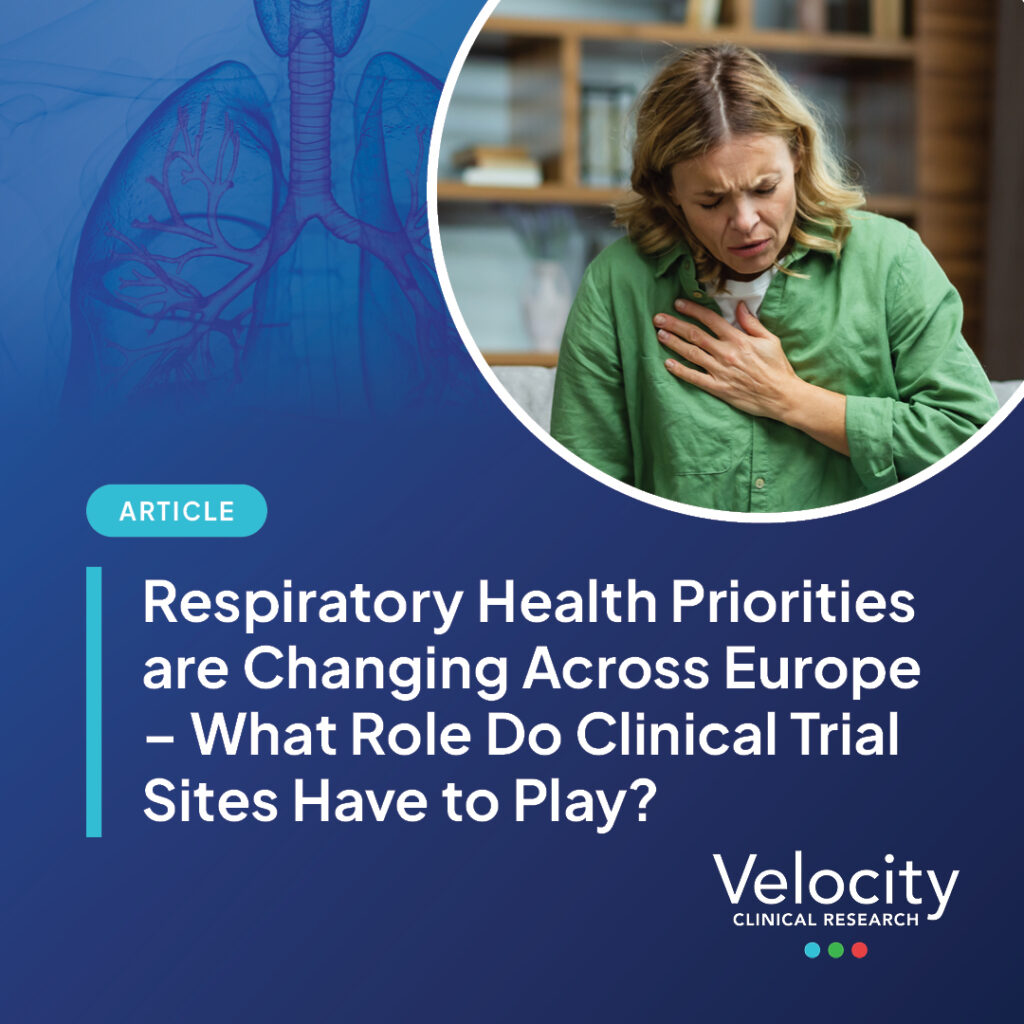For decades, research into respiratory health has centered on conditions such as asthma and chronic obstructive pulmonary disease (COPD), predominantly because of their high prevalence. However, the incidence of respiratory diseases is increasing globally, with lesser-researched but equally debilitating conditions such as interstitial lung disease, pulmonary sarcoidosis, and pneumoconiosis affecting health statuses worldwide.
While clinical trial sites are often seen as following the protocols dictated by Sponsors and contract research organizations (CROs), their contribution to medical advancement extends far beyond passive adherence. Clinical trial sites are critical nodes within the drug development process. As the incidence of respiratory disease rises across Europe, the role of clinical trial sites in addressing these changing health priorities will become increasingly important.
The growing burden of respiratory disease
Cases of respiratory disease have surged across the world. In 2017, over 544 million people were living with chronic respiratory conditions — an increase of nearly 40% since 1990. Respiratory diseases ranked third in global causes of death, surpassed only by cardiovascular diseases and cancer.
The economic toll of respiratory disease is as significant as its impact on mortality rates and quality of life. In the EU alone, the cost of care for those with chronic respiratory disease was estimated at €380 billion annually in 2019. This includes at least €42 billion in lost productivity and €280 billion in the monetized value of disability-adjusted life-years (DALYs), the primary metric for quantifying the burden of a disease.
The legacy of Covid-19
While the rising incidence of respiratory disease was well documented before 2020, the COVID-19 pandemic has exacerbated this trend. The virus’s impact is threefold:
- It disrupted the tracking, diagnosis, and treatment of other respiratory conditions, such as tuberculosis (TB).
- Lockdowns negatively impacted overall population immunity, a factor noted in the US, UK, and China during their first winter post-lockdown.
- While the disease’s sequelae are yet to be properly understood, long COVID is now widely recognized. It is marked by hundreds of symptoms associated with multiple organ systems, including chronic respiratory symptoms such as persistent dyspnea and impaired lung function.
Shifting patterns of infection and environmental factors
There is mounting evidence that the pandemic also changed the typical pattern of respiratory infection. Measures such as social distancing and mask-wearing suppressed the transmission of common respiratory pathogens like influenza and respiratory syncytial virus (RSV). As restrictions eased, these infections rebounded sharply. The World Health Organization’s (WHO) European Respiratory Virus Surveillance Summary noted a rise in fever and cough during winter 2023, particularly among young children.
Influenza and RSV settled into more traditional seasonal patterns this year, but the incidence of other infections, such as TB and pneumonia, remains unpredictable. These shifting patterns complicate respiratory health management and highlight the need for ongoing research to track and respond to these changes.
Environmental factors also play a significant role in the increasing burden of respiratory disease. Air pollution has been linked to a wide range of respiratory conditions. Studies in the U.S. and U.K. both identified rising cases of lung cancer among individuals with no history of smoking, with the authors concluding that contributing factors could include air pollution, radon exposure, and occupational hazards.
The importance of clinical trial sites
Clinical trial sites are uniquely positioned to challenge the rise in respiratory diseases. As obvious as this may seem, it’s worth remembering that no new treatment — whether an inhaler, antibiotic, or therapy — can be developed without them.
While Sponsors typically establish clinical trial protocols, trial sites bring local knowledge that can help tailor these protocols to fit the specific needs of their patient populations. Velocity has more than 50 sites worldwide supporting respiratory and COPD studies and has enrolled over 7,000 participants. This diversity is increasingly important in respiratory health, where factors such as air quality, smoking prevalence, and occupational risks can vary significantly across different regions.
Access to patients is one of the most critical roles clinical trial businesses play. Finding eligible participants for respiratory disease trials can be challenging, particularly as treatments become more advanced and targeted at specific phenotypes. Well-respected Principal Investigators are instrumental in attracting participants and meeting enrollment targets.
Our trial sites include over 60 investigators supporting COPD and respiratory studies, the foremost of whom is Dr. Henrik Watz, based at our Ahrensburg site in Germany. Dr. Watz has co-led the Pulmonary Research Institute at LungeClinic Grosshansdorf (PRI) for the past seventeen years and is part of a team responsible for overseeing 300 studies.
A well-respected pulmonologist, Dr. Watz is known for his experience with pulmonology indications such as COPD, bronchial asthma, and bronchiectasis, and was involved in 10 presentations to ERS Congress in 2024, including the innovative COPD medication EpiEndo, a modified macrolide. This reputation means patients actively seek him out for inclusion in his studies.
Dr. Watz recently published results from the Phase 2 AIRLEAF trial, on which the Ahrensburg team served as the central sputum lab. His paper, the 250th of his career, is available in full on PubMed.
Changing health priorities and clinical trials
As respiratory diseases become more prevalent, the work of clinical trial sites is increasingly important in translating research into effective treatments. With changing patterns of respiratory health, the emergence of long COVID, and a growing number of non-communicable respiratory conditions, the contributions of these sites are more critical than ever in improving patient outcomes and addressing threats to public health.
Though protocols from Sponsors and CROs guide our work, clinical trial sites’ contribution extends far beyond mere compliance. We play an active role in advancing medical innovation, providing access to experimental treatment, and ensuring the integrity of clinical data. As the burden of respiratory disease increases, clinical trials will be critical in mitigating the economic and human impact, helping to improve outcomes for millions of patients worldwide.
If you’re leading a respiratory research program, explore how Velocity’s specialized sites and extensive respiratory capabilities can accelerate your trial at velocityclinical.com/respiratory.

